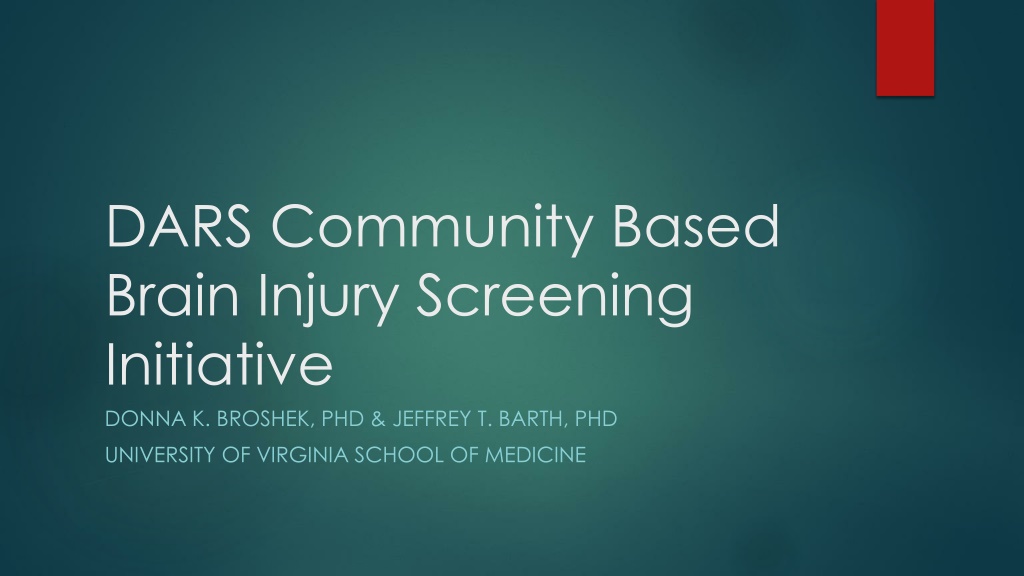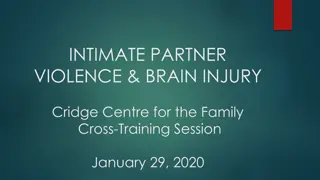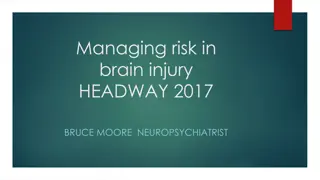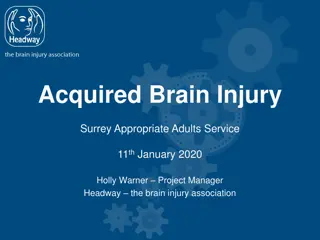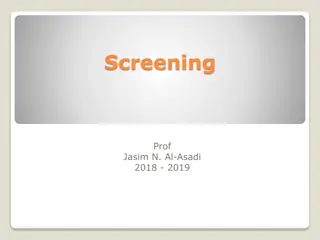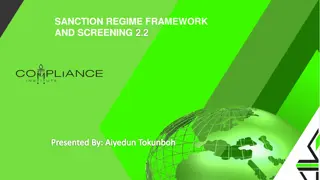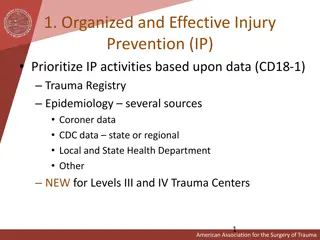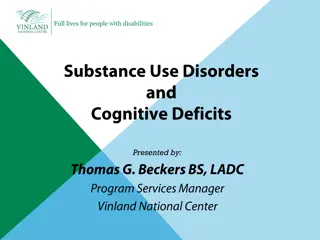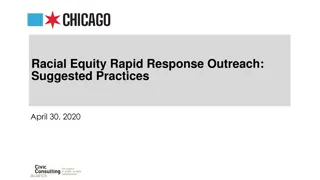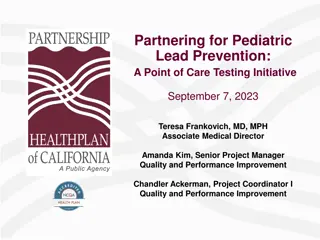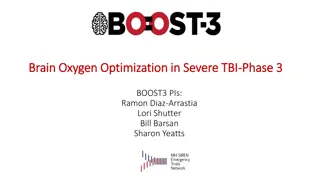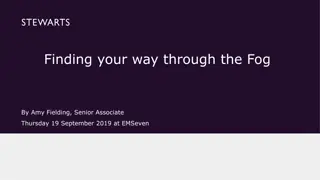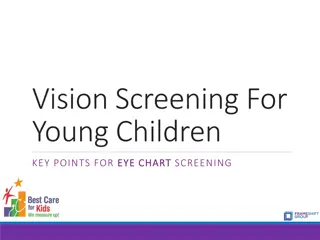Community-Based Brain Injury Screening Initiative at University of Virginia School of Medicine
Screening for traumatic brain injury (TBI) is crucial for identifying individuals with chronic TBI symptoms that impact productivity and social integration. The initiative aims to develop a brief, easy-to-administer TBI screening measure to assist community health organizations in identifying and referring clients with TBI diagnoses. The project involves a formal literature review to identify screening tools, development of training resources, and implementation in pilot sites across Virginia.
Uploaded on Sep 26, 2024 | 0 Views
Download Presentation

Please find below an Image/Link to download the presentation.
The content on the website is provided AS IS for your information and personal use only. It may not be sold, licensed, or shared on other websites without obtaining consent from the author. Download presentation by click this link. If you encounter any issues during the download, it is possible that the publisher has removed the file from their server.
E N D
Presentation Transcript
DARS Community Based Brain Injury Screening Initiative DONNA K. BROSHEK, PHD & JEFFREY T. BARTH, PHD UNIVERSITY OF VIRGINIA SCHOOL OF MEDICINE
Screening for TBI: Public Health Responsibility Identification of TBI is particularly important when the injury results in continuing symptoms (chronic TBI) that can lead to reduced productivity, poor community integration, and other social problems. Dams-O Connor, et al., 2014 History of TBI is rarely queried in primary care or other health service and educational settings, and its symptoms (if reported) may be inappropriately attributed to other causes such as aging, depression, or in schools, to learning or emotional disabilities. Gordon, et al., 1998, 2013 Failure to recognize the etiology of these symptoms precludes appropriate treatment or symptom management. Yi & Dams-O Connor 2013 [As quoted in Dams-O Connor et al., 2014]
Project Goals Why are we identifying or developing a TBI/ABI screening measure (PURPOSE)? To help community health services organizations identify clients with TBI/ABI diagnoses and assist them in determining whether the TBI/ABI diagnosis is contributing to their current problems. To help determine the appropriate treatment referral.
Project Goals What should the TBI/ABI screening measure look like (UTILITY)? Brief, easy to administer Does not require extensive training Provides the following information: Determination of whether a client has a TBI/ABI diagnosis Information about the severity of the TBI/ABI Symptoms related to the TBI/ABI Diagnosis and treatment options to guide referrals
Scope of Work (Three year grant project period) Initiate a formal literature review to identify screening tools for use by non-brain injury services providers to identify those with a history of brain injury. If appropriate measures not identified, a screening tool may be developed. Development of education/training resources for non-brain injury professionals on implementing a brain injury screening protocol. Will incorporate a train the trainer model to address staff turnover in community sites. Will consider the use of distance learning approaches (GoToMeetings, Skype, etc) for training in remote areas. A formal training protocol will be developed in Year 3, including a webinar and written protocol.
Scope of work (continued) Identification of and implementation of screening in 8 pilot sites across Virginia: Two Community Services Boards (CSBs) Two Centers for Independent Living (CILs) Two Area Agencies on Aging Two Free and Charitable Clinics UVA personnel to work collaboratively with DARS to complete the pilot study, including staff training, monitoring, ongoing assistance, and analysis of results.
Scope of Work (continued) Prepare a final report Describe screening protocol, staff training initiatives, and results Describe advantages, challenges, and recommendations for more widespread initiatives among non-brain injury community services programs. The report may include general policy and funding recommendations to improve access to brain injury services for citizens of Virginia through effective screening initiatives in community services programs throughout the Commonwealth.
Literature Review Ovid Medline and Pub Med search engines: 124,107 brain injury citations 109,860 community mass screening citations 83, 234 TBI citations 76,746 ABI citations 136 Combination citations (Combining either Brain Injury, TBI, or ABI AND community mass screening 12 relevant screening articles were identified and reviewed
Literature Review TBI screening instruments used in other states were also reviewed to assess their relevance for the Commonwealth of Virginia Community Based Brain Injury Screening Initiative. A total of 27 screening instruments were reviewed and evaluated based on these variables: Source of instrument TBI and/or ABI focus/inclusion Description Checklist Interview format Mental status or neuropsychological measure Number of items Intended population Administration time Advantages of the instrument Disadvantages of the instrument
Reviewed Instruments TBI/ABI Measures Brief Screening for Possible Brain Injury Columbus Public Schools Brain Injury Screen Colorado State Acquired Brain Injury School Age Iowa Head Injury Screening Instrument Brain Injury Screening Questionnaire TBI Screening DVBIC 3 Question Brief TBI Screen Brief TBI Screening New Mexico Brain Injury Screening Form Boston Assessment of Brain Injury Lifetime (BAT-L) MCV TBI Symptom Checklist TIRR Symptom Checklist HELPS Brain Injury Screening Tool Maryland TBI Screening Acute Concussion Evaluation (ACE) Minnesota Brain Injury Identification Ohio State U TBI ID Method Texas Brain Injury Screening MoCA DVBIC Post Deployment Screening RBANS Alaska Screening Tool MMSE Amen Brain System Checklist TBI Questionnaire Kansas Dept. of Aging Checklist
Selected Instruments Ohio State University TBI Identification Method Interview Form Brain Injury Screening Questionnaire (Gordon, Wayne State University) Both have advantages, but may be too unwieldy for use by non- brain injury services providers We are developing an additional measure designed for screening of patients with TBI/ABI Will be designed to be brief and to be administered by non-brain injury services providers.
Next Steps Develop a new screening tool for inclusion in the pilot study Add a preliminary pilot study to select the instrument best fitting the project goals (purpose & utility). Identify community programs for the pilot study (in progress) with Ms. Goodall & Ms. Cantrell of DARS Develop the methodology for the full pilot study Develop submission for Institutional Review Board (IRB) review and submit to the UVA IRB for Social and Behavioral Sciences.
